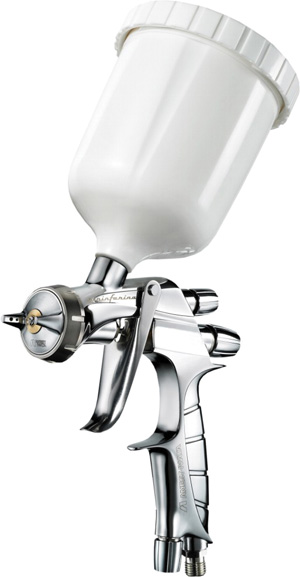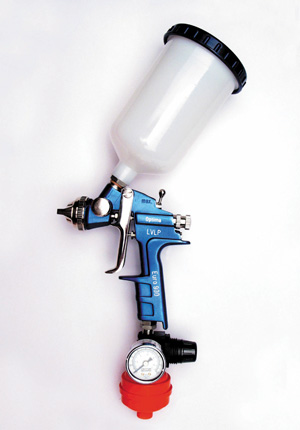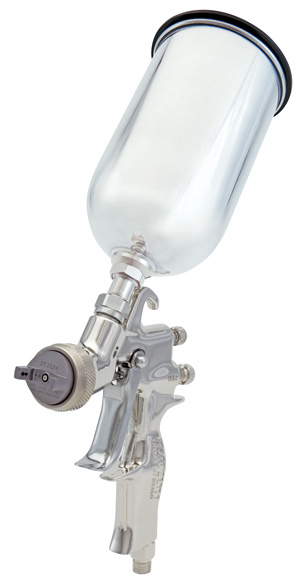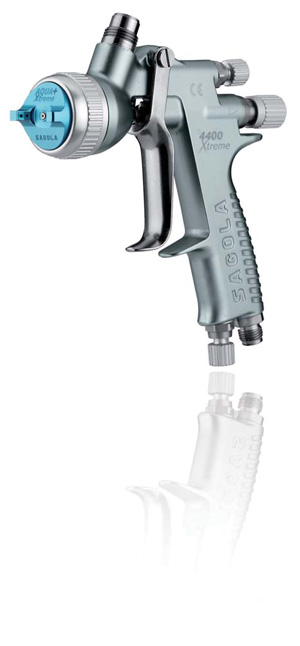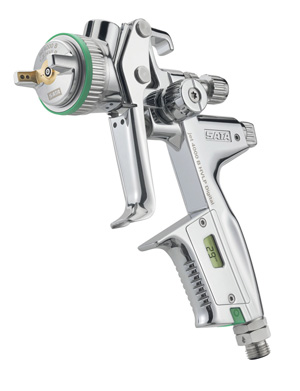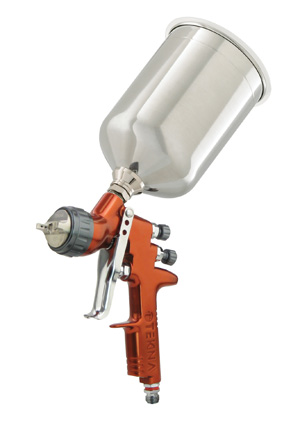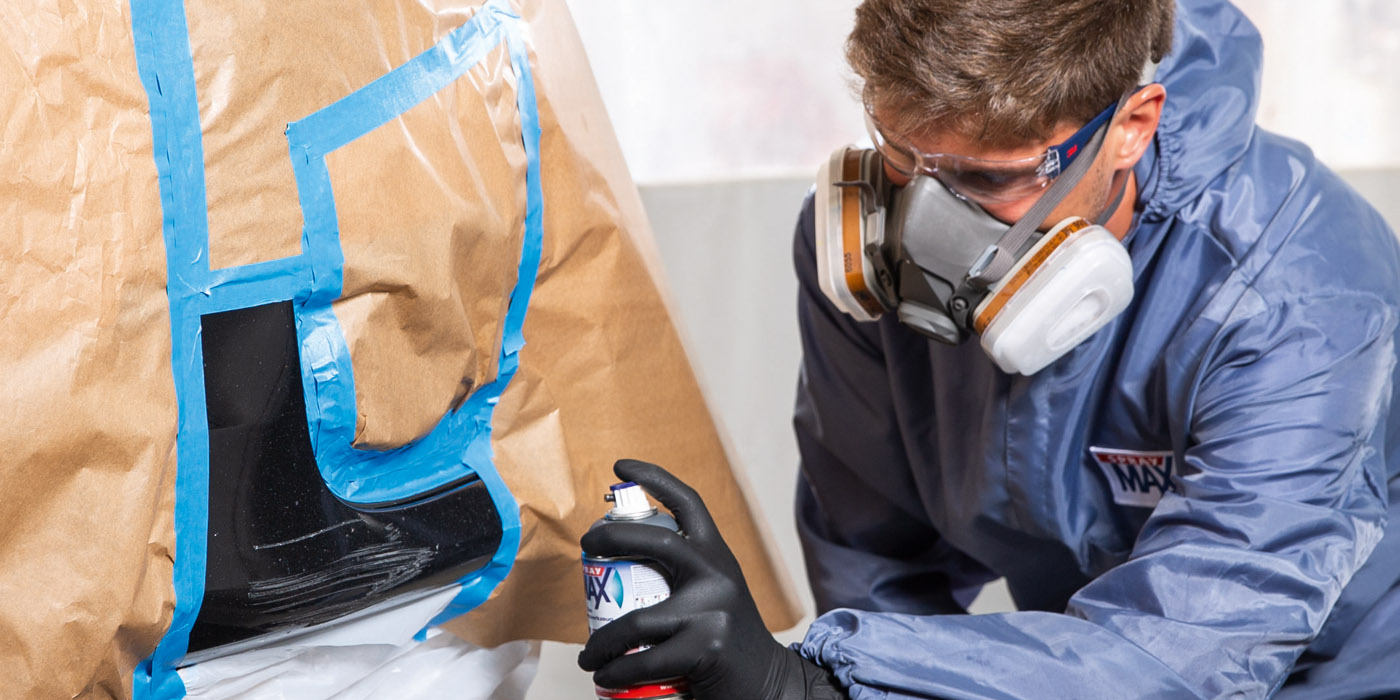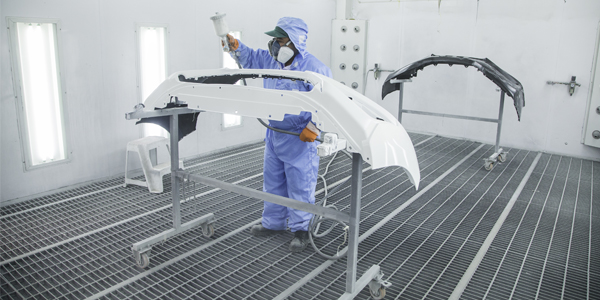Years ago, if you wanted a spray gun, the selection you could choose from was limited in terms of professional-quality equipment. Today, there are many more options.
Much like the auto market that expanded from only a few car brands to a whole lot more, the global nature of today’s business has dropped a plethora of spray guns into our laps. So come along with me and we’ll take a brief peek at the choices available to shops in the spray gun market.
HVLP
In addition to the market changing, the environmental gods demanded that we stop blowing a cloud of overspray to paint a car, a movement which yielded us the High Volume Low Pressure design (HVLP) of spray guns.
The early HVLP guns were standard high pressure units with hogged-out passages to allow a greater volume of air to atomize the paint stream exiting the tip. Before these were siphon guns that used a considerable portion of the available compressed air supply to create a low pressure zone above a cup of material, which would suck it up to the passages on the way to the tip. Now, the siphon design has all but disappeared and gravity guns have become standard.
The Environment
The U.S. federal government established the 6H Rule, which mandates that shops performing auto refinishing use technologies and best practices (high-efficiency spray technology) to minimize the emission of paint overspray (40 CFR 63.11173(e)). In other words, all auto painting must be done with HVLP spray guns or equivalent U.S. EPA-approved technology, such as an electrostatic or an airless design. If a shop chooses an alternative high efficiency spray technology, documentation must be obtained from the equipment manufacturer stating that the technology has been approved by the U.S. EPA administrator as equivalent to HVLP.
HVLP guns were developed to improve transfer efficiency over traditional air spray technology. HVLP transfer efficiency is a minimum of 65 percent as long as the pressure at the aircap doesn’t exceed 10 psi (0.7 MPa, 0.7 bar). Finish quality is similar to conventional equipment, but the spray rates are lower than conventional air sprayers. In virtually all areas of the U.S., HVLP technology is required for environmental compliance.
The lesser known configuration is Low Volume Low Pressure (LVLP), which is a variation on HVLP technology. LVLP uses a low volume of air to atomize the coating compared to the high volume of air for HVLP. At 16 psi (0.1 MPa, 1.1 bar), LVLP offers the same transfer efficiency as HVLP. Due to the low CFM requirements, LVLP is a good option when shop air supply is limited.
Manufacturers
Download a chart listing spray equipment manufacturers and specs on available models.
The following is a roundup of spray equipment manufacturers with products designed for and used in U.S. shops:
SATA (www.sata.com): German manufacturer SATA developed its presence in the market in Europe. Originally known as Sanitaria, in 2002 the company changed its name to SATA Farbspritztechnik GmbH and Co. According to corporate information, SATA as well as other high-line manufacturers have been the target of industrial piracy and design infringements. There was a SATA forgery branded SATEX made by Turkish firm Mersin, which was presented with the 1999 Plagiarius gnome award, deemed a derogatory award for one of the most brazen forgeries.
SATA is sold in the U.S. by Dan-Am, an independent company acting as exclusive authorized importer for SATA. Known for its SATAjet line of spray guns, its new SATAjet 4000 B is a top seller. The company claims its guns have an “unrivaled spray pattern” that’s second to none.
The SATAjet 4000 B is available with a digital air pressure gauge incorporated into the gun’s handle that’s impervious to solvents encountered in typical gun washers and is powered by a small battery located on the other side of the handle.
The SATAjet 3000 B features a chrome finish and is also available with the air pressure gauge in the body.
The SATAjet 100 BF gun designed for the application of primer and filler materials features low overspray and characteristics associated with SATA’s other HVLP designs.
Anest Iwata (www.anestiwata.com): Anest Iwata, a Japanese manufacturer that sells spray guns in the U.S., joined with industrial and auto designer Pininfarina, known worldwide for its automobile design, to create the Supernova line.
The technology found in the Hybrid LS-400H Supernova creates a double “engineered atomization” process within the sprayed coating, known as LV technology. LV works by focusing air down the special slits in the fluid nozzle that direct air toward the center of the nozzle orifice. This change in direction also causes the air stream to speed up, meeting the fluid in the center of the tip where powerful atomization occurs. This atomization (termed pulverization) is a pre-atomizing step which expands the paint stream four to five times that of the fluid opening and makes it a mixture of air and paint rather than fluid only. This air and paint mixture is much easier for the main atomization to break up, resulting in lower operating pressures. The secondary air cap piercings then complete the main atomization.
DeVilbiss (www.devilbiss.com): DeVilbiss is a name familiar to most veterans of the collision repair business. The company produces an array of products for fluid atomization for industrial, medical and automotive fields. Its guns are sold under the Tekna and CVi labels, and they also have a line of Dagr airbrushes.
The company was founded in 1888 by Ohio physician Dr. Allen DeVilbiss, who combined a bulb, some tubing and the base of an oil can to create the first atomizer for health care.
In 1907, Thomas DeVilbiss, a descendant of Allen and an inventor also, adapted the original atomizer to spray finishing. Mass production was beginning to evolve at this time, and DeVilbiss’s spray gun found its way into paint and lacquer coating applications on the furniture and automotive finishing assemblyline. Spraying the lacquer reduced drying time to hours instead of weeks, and the spraying of paint replaced hand brushing, helping to create new jobs and increase productivity in manufacturing.
DeVilbiss recently acquired the assets of the Binks Manufacturing Company, which had been its main competitor. In unregulated areas of the world, the old Binks Number 7 conventional suction feed gun is still sold.
Sharpe (www.sharpe1.com): Sharpe is a U.S. manufacturer of spray equipment headquartered in Minneapolis with a plant in Sioux Falls, South Dakota. The company says its guns are competitively priced and are known for their quality and reliability.
Sharpe says its best gun is the Razor. It’s made in the USA and has a 14-inch fan and 100 percent stainless steel fluid passages, needles and nozzles. Sharpe says the Razor offers long-term affordability with long-life needle packings and low cost of ownership due to the availability of cost-effective repair parts. Other features include a nickel-plated finish and three-year guarantee. The Razor line is available in a wide range of tip sizes.
Sharpe also offers the Finex line of spray guns geared toward cost-conscious painters. They come with a one-year guarantee.
Dura-Block (www.dura-block.com): Dura-Block, a subsidiary of Trade Associates Inc., is best known for its wide assortment of sanding blocks made from durable foam. But it also produces a professional line of spray equipment for body shops.
Its 007 Extreme line features drilled-out triggers that remind one of the cockpit of a race car and have a swoopy-looking, anodized body.
The guns also feature quick-releasing material cups, which Dura-Block claims allows for the transfer from color to clear without cleaning the gun – just twist the coupler, switch materials and trigger the gun.
Motor Guard (www.motorguard.com): Motor Guard is best known for its inline air filters, which used a roll of toilet paper to filter and dry compressed air, a standard piece of equipment I personally used for decades. It also makes the familiar orange filters that attach to spray gun handles, which were popular in U.S. shops in the ’80s and early ’90s.
Manufactured in Germany, the Optima line handles primer to basecoat, from color to clear. Features include stainless steel needles and nozzles with Teflon seals, built-in air regulation and lightweight balance for less fatigue.
Motor Guard claims the Optima guns reduce refinish times and material consumption and result in final finishes meeting industry standards. The Euro 900 offers minimized overspray based on its LVLP design, yet despite not being HVLP, Motor Guard claims the equipment produces good atomization at lower pressures.
Sagola USA (www.sagolausa.com): Spray Equipment Associates is the American importer of SAGOLA spray equipment, located in north New Jersey just west of New York City. Sales agents and dealers can be found throughout North America. Sagola’s main factory is located in the north of Spain near the French border. The company has been in business for over 60 years and offers HVLP, EPA compliant, conventional, airless and air-assisted airless spray equipment in all price and quality ranges for the professional painter in the auto refinish, industrial and wood finish markets.
The 4400G Xtreme comes in three models: digital, external hand tightened regulator with pressure gauge, and internal air regulator. All parts are stainless steel, and there are no O-rings or gaskets between air and paint, so painters can disassemble the whole paint area without manipulating any gaskets.
Walcom USA (www.walcom-usa.com): Walcom USA is the U.S. division of Walmec. An Italian manufacturing company, it has been supplying compressed air and spray equipment to the body shop industry since 1945. It makes air drying components, spraybooth accessories and paint guns.
It claims its Genesi line, with guns of chemical nickel and chrome finishes, features a high level of atomization and greater product savings than its previous series (FX).
The gun is constructed with an air valve and needle on a single axis to provide higher performance and simpler maintenance. Genesi GEO is an HVLP gun with a nozzle that exploits the principle of dual atomization: the first one inside the nozzle goblet, the second one through the cap atomization holes.
It’s recommended for both bases (water and solvent) as well as for transparent high solids material and very high solids paint products.
Download a chart listing spray equipment manufacturers and specs on available models.
Charlie Barone has over 36 years of experience in collision repair. He’s an ASE Master Certified technician and a licensed damage appraiser, and has been writing since 1993. He can be reached at [email protected]. 
